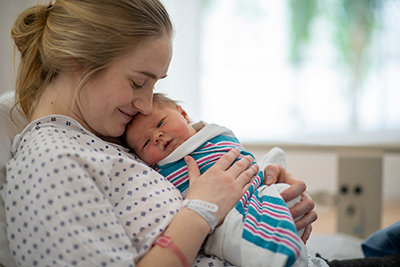Your Newborn’s Appearance
 Whether you are a new or veteran parent, you may be concerned or curious about your baby's appearance or behavior. Many of the conditions described here are common in newborns and will diminish or change as your baby grows. If you have specific concerns, do not hesitate to reach out to your baby's pediatrician.
Whether you are a new or veteran parent, you may be concerned or curious about your baby's appearance or behavior. Many of the conditions described here are common in newborns and will diminish or change as your baby grows. If you have specific concerns, do not hesitate to reach out to your baby's pediatrician.
-
Skin Conditions
Peeling or cracking skin around the wrists or ankles is common, especially in babies who have gone past their due date. As new skin cells grow, this condition will clear up without treatment. Newborns often have a lot of downy fuzz on their backs, arms and ears. This will soon rub off and disappear. Newborns also have a white, waxy coating that protects their skin. This is usually removed during the baby's first bath. It will be absorbed through the baby's skin within 24 hours after birth, if not removed during the first bath.
Some additional, common skin conditions include:
Stork bites
Many new babies have red areas around their foreheads, eyelids, and noses or on the backs of their necks. They are called "stork bites." They will be more visible when the baby cries and disappear by itself during the first year.
Milia
These look like "white heads" or pimples. They usually appear on the nose or chin. They usually disappear by themselves in the first weeks of life. Do not squeeze or put cream or lotion on them.
Rashes
Newborns often have rashes (reddened areas with an pinhead sized yellow or white raised center) that usually come and go during the first 10 days of life. These are normal and will soon disappear without treatment.
A raised pimple-like rash around the cord or genital area may occur. Usually this rash will clear up with normal bathing, sunbathing, or exposure to air. If the rash does not go away or increases, see your healthcare provider. A more severe blister-like rash that ruptures, leaves a scab, and continues to spread should be checked by your healthcare provider.
Skin rashes can also result from overdressing or harsh laundry soaps. As the baby becomes warm and sweats, skin irritation develops in skin folds. Keep the areas clean and dry, and avoid overdressing. You can also try a milder laundry soap, dissolve the soap before adding clothes and rinse twice. It is not recommended to put lotions or creams on a newborn's skin.
-
Acrocyanosis
Your baby's hands and feet may look blue for the first few days. This is normal. If you notice other parts of the baby turning blue, call your baby's healthcare provider immediately.
-
Sneezing
Babies clear their noses by sneezing. A stuffy nose, which is most noticeable when the baby is nursing, is common during the first days of life. It is caused by the swelling of the mucus membranes in response to the hormones from the mother. Breathing may be noisy and irregular at first. Soon you will get accustomed to your baby's habits.
-
Eyes
Your newborn may have swelling around the eyes. This will disappear a few days after birth. Some babies also have a red area in the white part of the eye. This is a small hemorrhage from the pressure during birth. No treatment is necessary, as it will disappear within several weeks.
A newborn can only see well for 8 to 12 inches. When an object is moved beyond this range, your baby's eyes wander and may appear crossed. As the eye muscles mature, your baby will be able to focus both eyes on the same object at the same time.
-
Head
Your infant will have a very large head in relation to the rest of the body. At birth, your infant's head takes on a melon-shaped appearance to help it fit through the birth canal. It will return to its normal shape a few days after birth.
Your baby will have soft spots (fontanelles) on the top of the head where bones are still growing together. A thick membrane covers these spots to protect the head and brain. You may gently touch these spots. Soft spots close completely by 2 years of age.
-
Crying
Right from the beginning, you should realize that babies cry and have fussy periods. Crying is their way of communicating (and relieving tension or boredom). Babies may cry for food, when uncomfortable, bored or in pain, or if they just want to be held close. Your baby may cry for several hours at the same time every day for no apparent reason. Sometimes babies cry from too much stimulation. If you suspect this is the case, take your baby to a quiet, darkened room so he or she can calm him or her self.
At times you will be able to comfort your baby very easily, and at other times nothing will work. Stay calm! Otherwise the baby will pick up on your discomfort. You may need to hand the baby to a different pair of arms and walk away for a few minutes. Never shake a baby. If the cries continue for long periods of time, call your healthcare provider.
-
Hormones
The effects of hormones may cause your newborn to have some swelling in the breasts or scrotum or a little bloody fluid/mucus coming from the vagina. These will go away and do not require treatment of any kind. Leftover hormones from Mother may cause both boys and girls to have swollen nipples. This swelling will go away a few days after birth.
.svg?iar=0&hash=F6049510E33E4E6D8196C26CCC0A64A4)

/hfh-logo-main--white.svg?iar=0&hash=ED491CBFADFB7670FAE94559C98D7798)